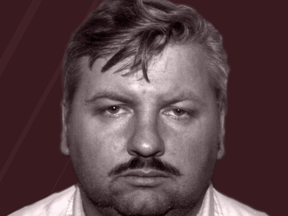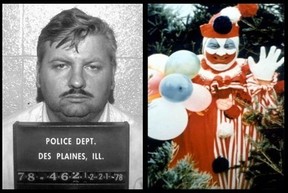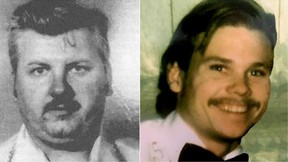
Article content
To famed defence lawyer Karen Conti, the most terrifying thing about serial killer John Wayne Gacy was the absence of menace.
Advertisement 2
Article content
The Chicago contractor had been convicted of 33 counts of first-degree murder in 1984 for the rape, torture and murder of 33 young men and boys from around 1972 to 1978.
Article content
In a macabre touch, Gacy — who moonlighted as a clown for charity— buried most of the bodies in a crawl space beneath his suburban bungalow.
For these sickening crimes, he rotund killer was sentenced to die in Illinois’ electric chair (later lethal injection).

Conti had the unenviable task of trying to save the life of the killer clown.
“It was a fluke,” she told The Toronto Sun from Chicago. “My late husband and I had a practice specializing in First Amendment cases. The government had now set his execution date and the prison was suing him. They hated him.”
Article content
Advertisement 3
Article content
That launched Conti on an odyssey to save Gacy from the needle. She says now that it had less to do with Gacy — who had a fair trial, superb lawyers and was clearly guilty — than other men and women on death row who might be innocent.

Conti is now telling the Gacy story from the front seat in Killing Time with John Wayne Gacy: Defending America’s Most Evil Serial Killer on Death Row.
“I have always been against the death penalty, and so I was added to the appeal,” Conti said, adding that Gacy’s everyman demeanour shocked her.
Recommended video
“He was completely normal, charming but a bit of a know-it-all. There was nothing out of the ordinary about him,” Conti said. “No one would think he was capable of the terrible crimes he was convicted of. He was a sociopath but seemed totally normal.”
Advertisement 4
Article content
Conti said the notorious killer was “not frightening” and she agreed when I quoted William Shirer from Rise and Fall of the Third Reich. Shirer described the Nazis as the “banality of evil.”

The lawyer added that suspected Gilgo Beach serial killer Rex Heuermann, a 60-year-old architect from Long Island, fits the template of normalcy.
“There’s a lot of similarities there,” Conti noted. “They can be very hard-working and productive in their day-to-day lives. They can be ambitious. Gacy cut his elderly neighbour’s lawns, went to church and would host neighbourhood barbecues.”
As the days ticked down in 1994 to Gacy’s express train to oblivion, Conti said her struggle was the death penalty itself. She had no illusions about John Wayne Gacy or the heinous crimes he was convicted of.
Advertisement 5
Article content

“No, I never had any doubts about his guilt, or what I was doing to try and save his life,” she said. “For a lawyer, it was the ultimate challenge, like running a marathon or climbing a mountain.”
She added: “To me, representing him was bigger than Gacy. It was about something bigger. We didn’t save Gacy, but we moved the needle against the death penalty in Illinois.”
The state eventually ended executions after 12 different men walked off the state’s death row. They were innocent.
“Twelve out of twelve. That’s not a very good batting average,” the lifelong Cubs fan said. “Particularly when it’s the state putting people to death.”
For seven months, from October 1993 to May 10, 1994, when Gacy got the big adios courtesy of a poison-packed needle jabbed into his chubby arm, Conti lived and breathed the case. She was in denial until the killer breathed his last.
Advertisement 6
Article content
“I don’t know if I ever came to grips with the fact he was going to be executed,” she said, adding that “Gacy was in denial mode, too. I think it helped him face what was coming.”
Gacy grew up with an abusive, alcoholic father, who inflicted blows to the part of his kid’s head which controls a person’s impulses and empathy. Gacy, of course, had none.
“Millions of people have grown up in worse circumstances and they don’t become sadistic killers. Sadly, these things aren’t out of the ordinary,” Conti added.

Thirty years after he was executed, Gacy’s twisted legacy continues to grow like a dead man’s fingernails. Cops are still identifying Gacy John Does at the Cook County morgue, and speculation about more victims has grown in volume. And there’s the nagging question: Did he act alone?
Advertisement 7
Article content
“Gacy did not commit all of these crimes alone,” Conti insisted. “I simply don’t believe a man his size could wiggle his way into the crawlspace under his house where he buried the bodies.”
His plausible connection to pedophile pimp John David Norman, who ran a nation-wide underage sex ring that supplied boys to sick men of power and influence, is one marker. A possible connection to Houston serial Dean “The Candyman” Coryll is also tantalizing.
“Coryll and Gacy were very similar. What Coryll was doing was very similar to what Gacy was up to in Chicago.”
As for Gacy, despite fighting to save the killer clown’s life, Conti reserved her sympathy for the young boys and men whose lives he had so mercilessly snuffed out in a six-year rampage.
“He wasn’t a friend. Gacy was a shell of a person. A sick sociopath,” she said. “Still, it was difficult having a client die on your watch.”
When the end came, Conti was surprised that Gacy’s family, neighbours and friends were there for him. They cried, they hugged.
“They loved this guy. It was really hard to see,” Conti said.
@HunterTOSun
Article content






